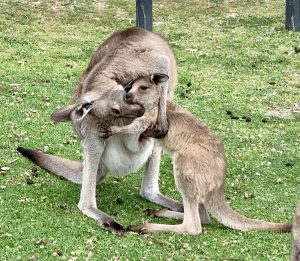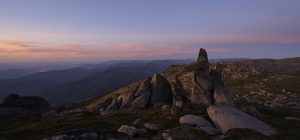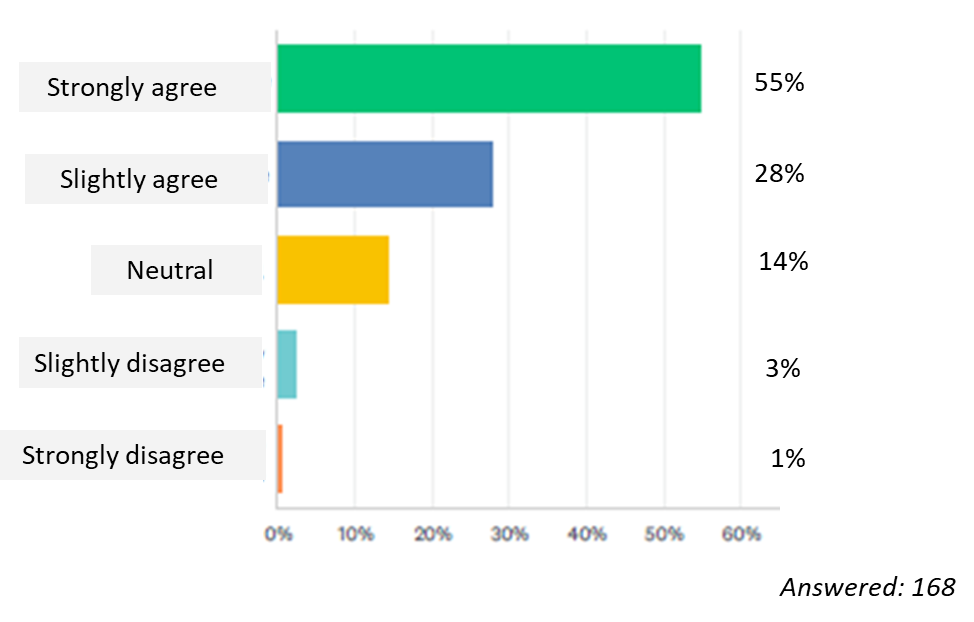On Friday ‘Good’ there we stood with the Coricudgy in far sight.
With final tweaks to the packs on our backs – a slight heave left & right.
We bid farewell with a nod and a wink, we’ve got this – you’ll see.
We’re off then – our lungs ‘chock-a-block’ – a rhythmic stride us three.
The grade got steeper, our gait shortened up – we’ve now hit reality.
Saplings appeared, undergrowth thickened and fallen trees hindered the ways.
Firm in our mind the known fact – stored water must last two days.
Then out of the bracken a sign post appeared – Coricudgy or Hunter Main Trail
Swift choice, Hunter Main Trail – we’ll walk the planned distance without fail.
But fail we did with the weight of the carry and our bodies seemly weary.
Shoulder to shoulder saplings now rise from a trail – once compacted and dreary.
The wreckage of fires, storms and land slips resulted in trail passage – a farce.
To think one could walk without blundering step – was knowledge that’s simply sparse.
Short of our target with a great threat of rain ‘n’ the wind with a blistering throe.
Rain it did with the push of time, we were sure our tents would go.
The camp was established at an opportune site, sheltered by a Rocky Bluff.
‘Save for’ an anchor to peg rock or tree – proved our tethering was made of good stuff.
With laboured yawn, quick rub of eyes – our bodies still seemingly aching.
The crisp breath of dawn accompanied our yawn to start our bodies a shaking.
The shrill from the dawn bird gave call to rise and welcome a brand new day.
We crawl from tents onto wet sodden ground, muttering ‘four letter words’ on the way.
Oh Saturday’s rise to bitter blue skies and rain mist that’s already proved dreary.
We stretched and nodded with circular gaze and cursed like Farther O’Leary.
We scoffed some breakfast we stuffed soggy packs, at last we’re ready to ‘roll’.
But delay to the start further stifled our heart and surely did sodden our soul.
Intent on regaining lost time, we now fixed on a better day’s sum.
But there at the ready were trail statuettes – of Myrtle and Wattle and Gum.
T’was fresh water we seek from Coachwood Gully, a spring, 12k’s down the track.
The pace was slowed the further we go‘d – thru vine ‘n’ thistle ‘n’ fern we’d hack.
Now the spilling of ‘springs’ gave joy to our ears as we approached the Coachwood seep.
The joy was short lived – as the water ‘let fall’ was from a level – too distant – too steep.
We scooped trickling water from the trail’s sullied surface – yet not a welcoming blend.
We topped reserves, quenched our thirst – allowing our worries to mend.
With dimming skies/stumbling feet – realising the target – we’d fail.
Oh’ for a camp site that’s rock free & level – we’d raise our arms and hail.
There we stood, peering ahead as much as the landscape allowed.
But no such site availed itself, aside from the Hunter Main Trail, whose timbered
growth would stand steadfast and form a protective shroud.
By torchlight that night we circled the ‘wagons’ and discussed our ambitious campaign.
The first to wake would summon the ‘rally’ – without further voice of disdain.
While agreement was made to break camp early – before the hint of ‘first light’.
The Moon’s outstretched fingers, had traced on the ground – Easter Sunday’s delight.
In respect of belief we paused to give thanks then shared our eggs around.
But we refrained from tradition to hide the eggs, simply placing them on a mound.
Breaking camp, quick check of the map to ensure matching numbers we yearn.
Off we strode thru the eerie blue light – towards the ‘point of no return’.
With reserved excitement, quick glance around, we gave the Garmin a check.
A tentative voice was heard to say, not far, just up ahead, I think we’ve got it by heck.
The point to exit the Hunter Main Trail into a gully – so timbered – oh so steep.
A route devoid of direction – down to the banks of Blackwater Creek.
Marking our exit with a ribbon or two we also recorded, grid reference.
Over the ledge us – one two three, to centre the gully was preference.
We gazed around and then looked down to see what we had encountered.
Confirming the grade that we would battle was not one, for the fainthearted.
Many trees had fallen due to rot and decay, thus exposing Tuff’s Rock and grass.
But the rocks were loose and the grass was slippery – we promptly fell onto our brass.
To slow down descent we used our packs to drag tracks and act as a temporary brake.
At each opportune moment we’d slowly rise (some tears in our eyes) – to pluck the burrs
from our arse.
With a grade 1 in 6 and narrowing rock shelves the pace slowed to just a dawdle.
The descriptive expression of some sections to pass – shall remain for all time inaudible.
There lying in wait was a silent bait, covering ground and rock and tree.
Discreet by nature, grey green lichen was defying the eyes to see.
Just add moisture nature declared – to find how slippery it be.
Down we went like bags of spuds to injure, a shoulder, a cheek, a knee.
Counting our blessings we assembled again and continued to the rocky ledge,
A quick ‘memory refresh’ of an abseil book, a plan was hatched, with a ‘sign of the cross’
and a pledge.
Ropes were produced to conquer the ledge, first lowering each backpack down.
Two sets of eyes then gazed on me; I stuttered and agreed with a frown.
We will let you go first, the lightest you be, best to test our knot.
I swung like a pendulum in a grandfather’s clock, when all the slack was got.
The ropes a ‘bit short’ was my retort, realising my feet hadn’t reached the ground.
A quick adjust that saved the day and a bit of a thud when my feet were finally found.
The lasting sweep towards Blackwater Creek was slow but worthy of ‘thy’.
Giant sandstone boulders, long narrow crevasse and a rock face seeking the sky.
With gully bed seemingly narrow, while bordered with sickening vine.
Backpacks required removal, with body and shoulders aligned.
Water increased around our feet that flowed with gathering tempo.
The gully meandered around every bend and dropped into every hollow.
We pushed and shoved dead branches, we skidded on rolling rocks.
The gully bed slowly widened, in short – we had smiles like Goldilocks.
Then was heard the rigorous churning of water flowing afore us.
The mountains sent streams into Blackwater Creek; in parts – nearing ‘full flush’.
Wounded bodies with tempered minds, we finally broke vision upon her, where
time stood still, as we endorsed our will – for the past 3 k’s were tough.
The joy of our meeting enormous, emotions running high, us three blokes in the rough.
She looked so sleek in her movement, her swish ‘n’ sway, with very impressive sass.
While her stream was wide, her banks either side were narrow and tricky to pass.
Again time was against us, we simply failed to complete – the best of a good days walk.
We elected to camp ‘on a snug little spot’ as there was nothing, elsewhere we’d gawked.
Around camp that night we discussed our plight with concerns of what lay before us.
Day 3’s poor achievement, 4k’s out of 9, gave cause for a curse and a cuss.
We rested that night the best we could, with a sloping site and our bodies worse for wear.
At dawn’s first light we peered down the stream and lamented the scene awaiting us there.
Oh blackwater creek you’re coursing’s unique, befitting the terrain that surrounds yee.
The carving you trace over each rapid’s race makes us proud to have finally found thee.
Fallen trees of ancient descent, once so grand ‘n’ noble, are now strewn across your way.
Large battered boulders embedding the sand like warriors defying the fray.
Your carry of water was swift and deep with bottomless pools in the hiding.
To conquer your route, one could not walk your bed, as the sand defied solid striding.
Your banks were steep with toes in the creek and access either side, concealing.
Straddling of boulders, clinging to branches proved clear-cut approach unappealing.
Blackwater Creek ‘oh’ Black water creek what is it from us that you seek.
We pursue you with kindness, we treat you with care, we wonder at your mystique.
Oh you treat us so cruelly, we think you unfair and sometimes you don’t really care.
Is this your true nature or healing you seek from treatment of our forebears.
Why is your water so black so bleak are you bleeding from what lies beneath.
Your name is befitting of the stealth you display, with the obstacles you bequeath.
You flow at will, with regular spill around hazards that are well connected.
You flow thru the groin of thighs, so high, so steep; your secrets are well protected.
Over three days we criss-crossed your flows with varying degrees of success.
On one occasion my legs disappeared into a seemingly sandy abyss.
I eagerly called for assistance, exclaiming I think I’ve got troubles – and
If you don’t pull me out any time soon I think you’ll be looking for bubbles.
Time after time we climbed your slopes to conquer the obstacles bestowed us.
The slopes themselves were a footprint to hell with a view that certainly feared thus.
With thickets of vine grass as high as our thigh and dense scrub obstructing our eye.
Walking was clumsy and hindered by holes and rocks and stumps and logs that lie.
Progress around and along your slopes was agonising and deliberate
Each step performed like a Kremlin guard, lift, stretch, place, transfer the weight
Lift, stretch, place, transfer the weight to stamp ‘n’ pack – swards of vine and grass.
Sweat drips, shirt rips, spill of blood running in silence – an unbearable way to pass.
Lawyer Vine – Oh Lawyer Vine I never knew you existed.
You lay in wait for each weary step with a plan that is utterly twisted.
You run at length upon the ground, hidden in bracken and grass.
You flourish on shrubs with low hanging branches thus blocking our chances to pass.
You invade the canopy of your surrounds and cling with fishhook fingers.
You have no place in this garden of lace – better suited where the Devil lingers.
You’d grab our ankles you’d grab our arms you’d noose our neck our packs.
You let us stride till the tension applied – then you jerked our bodies back.
Step by step we’d fight you off with an angst we failed to surmount.
Over & over we’d tumble & fall into a drunken sprawl – t’was too many times to account.
Ah – quick thoughts of ‘tracks’ with mown grass, all edged with a border of fern.
The weight on our hearts could not be defined on approach round every turn.
The burden on body – the burden on mind – a torment from nature herself.
For the realisation of any such ‘track’ – was ephemeral fiction with stealth.
Over the next three days we battled the maze, with our supplies now running low.
3k’s a day was the best we could make – on the map, really nothing to show.
Our last camp was kind‘a solemn, with pain of injuries that may long-term affect us.
We opened our tents, dragged our bodies thru, and managed to gain Homo Erectus.
Microwaves up and microwaves down – the heavens abuzz with concern.
The message of reply to our welfare – gave no confidence of an upturn.
The garmin seekers, still wearing sneakers, squirmed with disbelief.
Authorities of high degree were let know and offered standby relief.
On the seventh day we were advised we’d be met by a welcoming party.
Quick thoughts of the words, we’ve got your back, felt warm and kind of hearty.
The welcoming team arrived, to our surprise having drinks and food and face washers.
We shook hands and hugged the bad things we shrugged and continued in boots, with the
sound of wet galoshes.
In our quest for success there was never a ‘wrong’ decision made, but one must say, some
were more character building than others.
For must I declare, the days of steep climb, the days of wet clothes, the days of lawyer vine,
were likened to – ’10 rounds’- with Jimmy Carruthers.
In agreeing to walk Blackwater Creek I couldn’t tell if I’ve opened the door to heaven or hell.
If there’s a God in heaven then I’m fairly sure he’s got it in for me, right now I think I can tell
Memories – Oh Memories of events that were bestowed us
I remember the washed out drains that prevented car access at start
I remember first sight with some delight when we first encountered Hunter main
I remember the regrowth that nature provided to recover from the human zoo
I remember first night at the camping site, the blistering wind and the rain
I remember the end of each walking day to feel defeat in one’s toiling heart
I remember the leadership when moods were low, ‘triangular method’ as we all had a go
I remember the moments on Easter Sunday as we gave thanks in a personal way
I remember the scents and the sounds that enlivened true enjoyment in me
I remember descent into Blackwater Creek the experience beggars’ belief
I remember the slips, trips and falls and consoling laughter that fell upon deaf ears
I remember the ‘labels’ we each had carried, like “three points” “wombat” and “stirrer”
I remember the eerie calls at night, not knowing on foot or by flight – and
I remember at night the perils encountered – just for the need to pee,
I remember each morning the shock on my feet, when sliding into – sandy wet socks
I remember the sheer frustration on faces of those with lingering pain
I remember no ill word was ever spoken, just a need to grin and refrain – and
I remember the flak, that I got back, on saying – “just follow the water/ just follow the water”,
whenever the garmin was showed
They say good friends are made in times when the going gets tough
They say good friends are made of, generally bloody good stuff
They say good friends can see through the limits and faults of others
I ask you then, who you think will remain good friends if ‘dark fortune’ should shine upon us
In the safeguarding of pride, real names I would hide, as the intent was not to claim fame.
But for the sake of this story, if you must apply glory, then refer to Eric & Wayne & Graham
While feeling pretty chuffed and proud that we had walked, from where we once started,
came a whispering voice from the cool of the creek, “I warned you it was not for the faint
hearted”.
We thank those who assisted, we thank those who collected and we thank those waiting at
home.
With apprehension, a little tension, we thank Mother Nature herself, in a kind’a guarded tone.
When describing to others the thrill of the walk they listened with a sense of boon.
Then befalls the age old question, – now that you’ve done it, would you do it again.
Well….with a lingering breath and a laboured sigh, I proclaim with this reply!
Hell Yes…..that was only the RECCY!!
























